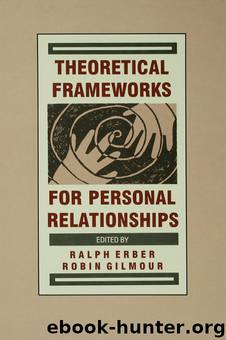Theoretical Frameworks for Personal Relationships by Unknown

Author:Unknown
Language: eng
Format: epub
ISBN: 978-1-134-75453-3
Publisher: Taylor & Francis (CAM)
Friendship in Middle Childhood
Sullivan (1953) suggested that in middle childhood children begin to form “chumships” (i.e., a close alliance with one other child). Chumships are stable peer relationships that provide children with companionship. Failure to develop a chumship is expected to lead to loneliness (Sullivan, 1953). Sullivan suggested two other benefits of chumship. First, children have opportunities to learn sensitivity to another and to try and understand another’s perspective. The learning of interpersonal sensitivity is viewed as an important precursor to altruism. Second, chums provide validation of children’s self-worth.
Several studies have examined friendship in middle childhood. Mannarino (1980) compared 10- and 11-year-old boys who did or did not have chums. The criteria for defining chumship were threefold: high scores on a chumship checklist (Mannarino, 1980), stable friendship choice over a 2-week period, and preference for the friend rather than playing with other friends. The two groups were matched on IQ and peer acceptance. Boys with chums reported higher self-worth and were more altruistic.
Other studies have found that school-aged children behave differently toward friends and acquaintances. When with friends, children are more affective, interactive, cooperative, and mutually directed (for a review, see Hartup, 1983). These studies suggest that collaboration with a peer is an important achievement at this age.
A similar view was offered by Gottman and Mettetal (1986), who suggested that friends are trying to build solidarity at this age. They suggested that children share gossip as a way to promote cohesion and closeness. Gottman and Mettetal found that unacquainted older children and adolescents who “hit it off” engaged in a greater amount of negative-evaluation gossip. These results suggest that exchanging gossip facilitates peer relationships in middle childhood by increasing the liking and cohesion in peer dyads.
In summary, participation in friendship at this age involves collaborating with a peer. Being sensitive to another’s wishes and sharing gossip with a peer are important skills for establishing and maintaining friendships.
Download
This site does not store any files on its server. We only index and link to content provided by other sites. Please contact the content providers to delete copyright contents if any and email us, we'll remove relevant links or contents immediately.
| Coloring Books for Grown-Ups | Humor |
| Movies | Performing Arts |
| Pop Culture | Puzzles & Games |
| Radio | Sheet Music & Scores |
| Television | Trivia & Fun Facts |
The Social Psychology of Inequality by Unknown(2989)
Make Comics Like the Pros by Greg Pak(2883)
Stacked Decks by The Rotenberg Collection(2844)
Purple Hibiscus by Chimamanda Ngozi Adichie(2740)
The Queen of Nothing by Holly Black(2545)
The Art of Doom by Bethesda(2131)
Life of Elizabeth I by Alison Weir(2052)
Putin's Labyrinth(1988)
The Power of Habit: Why We Do What We Do in Life and Business by Charles Duhigg(1970)
Drawing Down the Moon by Margot Adler(1844)
Things Are What You Make of Them: Life Advice for Creatives by Adam J. Kurtz(1835)
Agency by William Gibson(1800)
Wall and Piece by Banksy(1797)
Art Of Atari by Tim Lapetino(1773)
Teaching to Transgress: Education as the Practice of Freedom (Harvest in Translation) by Bell Hooks(1741)
The Beatles Lyrics by Hunter Davies(1695)
The Pin-Up Art of Bill Ward by Bill Ward(1675)
Only What's Necessary: Charles M. Schulz and the Art of Peanuts by Chip Kidd(1667)
The Andy Warhol Diaries by Andy Warhol(1576)
